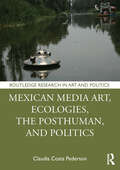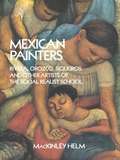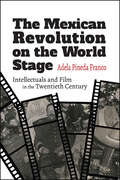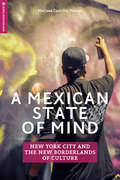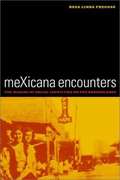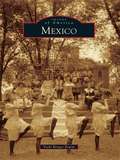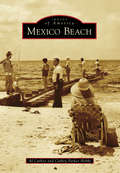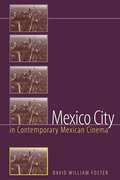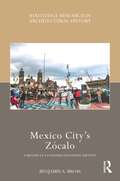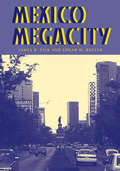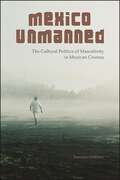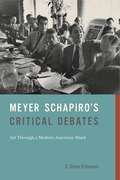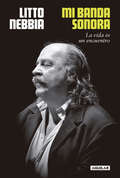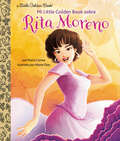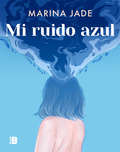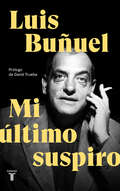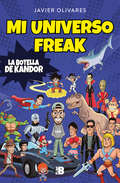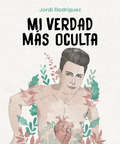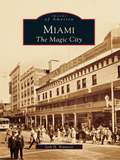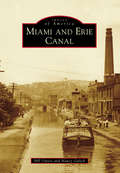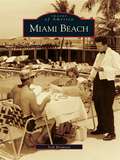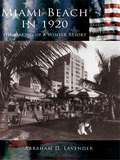- Table View
- List View
Mexican Media Art, Ecologies, the Posthuman, and Politics (Routledge Research in Art and Politics)
by null Claudia Costa PedersonThis volume focuses on the connection between ecological thought and the technological arts in Mexico in order to challenge assumptions that ecological thought is a domain exclusive to the arts of the Global North and reconceive it as an inventive nexus of materialist speculations into a global posthuman world.Tracking the concept of ecology through a series of case studies taken from the histories of new media arts in Mexico over the last 50 years (from the mid-twentieth century to the present), this book differs from ecological art histories that either ignore technological art or associate it exclusively with the Global North. It includes artists and collectives working both in Mexico and transnationally and examines collaborative projects responding to anthropogenic environmental degradation in Mexico and elsewhere.The book will be of interest to scholars working in art history, Latin American studies, media studies, and environmental studies.
Mexican Painters: Rivera, Orozco, Siqueiros, and Other Artists of the Social Realist School
by Mackinley HelmFrom the monumental public frescoes of Diego Rivera, José Clemente Orozco, and David Álfaro Siqueiros, to the canvasses and drawings of younger artists like Galván, Cantú, Meza, Tamayo, and Orozco Romero, Mexican painting since the First World War has developed into a strong, influential artistic tradition.This book explores this Mexican tradition -- the artists, their works, the social and political background, and the relationship of the modern painters to European and Mexican historical tradition. Helm, an important collector who knew most of the artists, writes informally yet with deep understanding about the major figures -- Orozco, Rivera, and Siqueiros -- as well as over 40 others little known outside their native Mexico.He ably ties together such diverse influences as the Revolution and the regime of Obregón, the Siqueiros Syndicate and its power in getting artists to pool resources and works for a powerful national style, Rivera's strong political beliefs and their effect on his work, Orozco's deep empathy, the development of the young artists, the effects of low wages and bohemian existence on artistic production, links to Indian art, the rediscovery of fresco technique, important patrons, the religious and anti-religious forces in the early works, and much more. In addition, 95 works by 37 artists are reproduced, showing the range and best works of modern Mexican painting.MacKinley Helm was in a uniquely favorable position to write about these artists, and his book is now considered the best introduction to the art and artists of Mexico during the great artistic movements of the '20s and '30s. Collectors, artists, and others who have felt the lack of solid information about this important Western tradition will find this book gives clear insight into the conflicts, personalities, and important works that have developed into modern Mexican art.
The Mexican Revolution on the World Stage: Intellectuals and Film in the Twentieth Century (SUNY series in Latin American Cinema)
by Adela Pineda FrancoThe first major social revolution of the twentieth century, the Mexican Revolution was visually documented in technologically novel ways and to an unprecedented degree during its initial armed phase (1910–21) and the subsequent years of reconstruction (1921–40). Offering a sweeping and compelling new account of this iconic revolution, The Mexican Revolution on the World Stage reveals its profound impact on both global cinema and intellectual thought in and beyond Mexico. Focusing on the period from 1940 to 1970, Adela Pineda Franco examines a group of North American, European, and Latin American filmmakers and intellectuals who mined this extensive visual archive to produce politically engaged cinematic works that also reflect and respond to their own sociohistorical contexts. The author weaves together multilayered analysis of individual films, the history of their production and reception, and broader intellectual developments to illuminate the complex relationship between culture and revolution at the onset of World War II, during the Cold War, and amid the anti-systemic movements agitating Latin America in the 1960s. Ambitious in scope, this book charts an innovative transnational history of not only the visual representation but also the very idea of revolution.
A Mexican State of Mind: New York City and the New Borderlands of Culture (Global Media and Race)
by Melissa Castillo PlanasA Mexican State of Mind: New York City and the New Borderlands of Culture explores the cultural and creative lives of the largely young undocumented Mexican population in New York City since September 11, 2001. Inspired by a dialogue between the landmark works of Paul Gilroy and Gloria Anzaldúa, it develops a new analytic framework, the Atlantic Borderlands, which bridges Mexican diasporic experiences in New York City and the black diaspora, not as a comparison but in recognition that colonialism, interracial and interethnic contact through trade, migration, and slavery are connected via capitalist economies and technological developments. This book is based on ten years of fieldwork in New York City, with members of a vibrant community of young Mexican migrants who coexist and interact with people from all over the world. It focuses on youth culture including hip hop, graffiti, muralism, labor activism, arts entrepreneurship and collective making.
Mexicana Encounters: The Making of Social Identities on the Borderlands
by Rosa Linda FregosoMexicana Encounters charts the dynamic and contradictory representation of Mexicanas and Chicanas in culture. Fregoso's self-reflexive approach to cultural politics embraces the movement for social justice and offers new insights into the ways that racial and gender differences are inscribed in cultural practices.
Mexico
by Vicki Berger ErwinAfter its founding in 1836, Mexico was named county seat of the newly formed Audrain County. Growth in the primarily agricultural region was slow until the coming of the North Missouri Railroad and the Graduation Act that made land available from the federal government for 12.5¢ an acre. With the introduction of breeding and training saddle horses, the discovery of fire clay deposits, and the implementation of more efficient means of turning the clay into heat resistant brick, Mexico's star ascended. During its heyday, the city was known as the "saddle horse capital" and the "firebrick capital of the world." Today Mexico continues to survive and thrive as "main street of the Midwest."
Mexico Beach
by Al Cathey Cathey Parker HobbsAs French interests in the Americas dwindled, records indicate very little activity around Mexico Beach until rumors of buried riches and sunken ships brought treasure hunters to the coast. In the early 1900s, businessman Felix du Pont purchased the land known today as Mexico Beach. Resin to make turpentine was harvested from the native pine trees, and fishermen could not resist the migratory fish passing through the area's waters. By the 1930s, US Highway 98 was completed, and visitors could finally reach the sugar-soft sand beaches of the "Unforgettable Coast." By 1941, Tyndall Field was constructed and became a training site for Air Force pilots. In 1946, a group of farsighted businessmen, led by Gordan Parker, W.T. McGowan, and J.W. Wainwright, purchased 1,850 acres along the beach for $65,000. Parker's son Charlie moved to the area in 1949 with his wife, Inky, and their family. He soon took over development responsibilities for the Mexico Beach Corporation and laid the groundwork for the beach town known and loved today. Charlie went on to become the city's first mayor and a lifelong advocate of the family-friendly community.
Mexico City in Contemporary Mexican Cinema
by David William FosterJust as Mexican national life has come to center on the sprawling, dynamic, almost indefinable metropolis of Mexico City, so recent Mexican cinema has focused on the city not merely as a setting for films but almost as a protagonist in its own right, whose conditions both create meaning for and receive meaning from the human lives lived in its midst. <P><P>Through close readings of fourteen recent critically acclaimed films, this book watches Mexican cinema in this process of producing cultural meaning through its creation, enaction, and interpretation of the idea of Mexico City. David William Foster analyzes how Mexican filmmakers have used Mexico City as a vehicle for exploring such issues as crime, living space, street life, youth culture, political and police corruption, safety hazards, gender roles, and ethnic and social identities. The book is divided into three sections. "Politics of the City" examines the films Rojo amanecer, Novia que te vea, Frida, naturaleza viva, and Sexo, pudor y lágrimas. "Human Geographies" looks at El Callejón de los Milagros, Mecánica nacional, El castillo de la pureza, Todo el poder, and Lolo. "Mapping Gender" discusses Danzón, De noche vienes, Esmeralda, La tarea, Lola, and Entre Pancho Villa y una mujer desnuda.
Mexico City’s Zócalo: A History of a Constructed Spatial Identity (Routledge Research in Architectural History)
by Benjamin A. BrossThis book presents a case study of one of Latin America’s most important and symbolic spaces, the Zócalo in Mexico City, weaving together historic events and corresponding morphological changes in the urban environment. It poses questions about how the identity of a place emerges, how it evolves and, why does it change? Mexico City’s Zócalo: A History of a Constructed Spatial Identity utilizes the history of a specific place, the Zócalo (Plaza de la Constitución), to explain the emergence and evolution of Mexican identities over time. Starting from the pre-Hispanic period to present day, the work illustrates how the Zócalo reveals spatial manifestations as part of the larger socio-cultural zeitgeist. By focusing on the history of changes in spatial production – what Henri Lefebvre calls society’s "secretions" – Bross traces how cultural, social, economic, and political forces shaped the Zócalo’s spatial identity and, in turn, how the Zócalo shaped and fostered new identities in return. It will be a fascinating read for architectural and urban historians investigating Latin America.
Mexico Megacity
by James B PickThis book describes and analyzes a wealth of data about Mexico Citys growth, change, and spatial patterns. Applying modern techniques of geographic information systems and cluster analysis, the authors reveal many previously unknown or unrecognized trends and patterns. The authors provide historical background, analyze key findings and relationships, and tie their results to the literature on Mexico City and other giant cities. The United Nations predicts the emergence of many more giant cities worldwide over the next quarter century, most of which will appear in the developing world. Mexico Megacity may be a milestone from a comparative perspective in increasing knowledge about one developing world megacity and offering analytical tools to study others. With a population of 15 million persons in 1990, Mexico City is one of the worlds largest cities. It is a famous center of civilizations and culture and one of the economic capitals of the Americas, but it also has serious social and economic problems, including large impoverished zones, severe environmental degradation, crime, and overpopulation. This book describes and analyzes growth, change, and spatial patterns in Mexico City, looking at urbanization, population, marriage and fertility, health and mortality, migration, environment and housing, social characteristics, the economy, labor force, and corporate structure. Applying modern techniques of geographic information systems and spatial analysis, the authors reveal many previously unknown or unrecognized trends and patterns. In a capstone chapter, they summarize the spatial patterns in a series of cluster analyses that identify distinctive zones within the metropolisa prosperous core, surrounding complex ring patterns, an impoverished zone, and semi-rural arms. They also compare the pattern of Mexico Citys cluster zones to the classical and developmental literature on cities. In closing, the authors suggest government policies that would foster optimal future development of an even larger metropolis. This book addresses a topic of growing importance. The United Nations predicts the emergence of many more giant cities worldwide over the next quarter century, most of which will appear in the developing world. Mexico Megacity is a milestone work that increases our knowledge about one developing world megacity while offering analytical tools for studying others.
Mexico Unmanned: The Cultural Politics of Masculinity in Mexican Cinema (SUNY series in Latin American Cinema)
by Samanta OrdóñezIconic images of machismo in Mexico's classic cinema affirm the national film industry's historical alignment with the patriarchal ideology intrinsic to the post-revolutionary state's political culture. Filmmakers gradually turned away from the cultural nationalism of mexicanidad, but has the underlying gender paradigm been similarly abandoned? Films made in the past two decades clearly reflect transformations instituted by a neoliberal regime of cultural politics, yet significant elements of macho mythology continue to be rearticulated. Mexico Unmanned examines these structural continuities in recent commercial and auteur films directed by Alfonso Cuarón, Carlos Cuarón, Carlos Reygadas, Amat Escalante, and Julio Hernández Cordón, among others. Informed by cinema's role in Mexico's modern/colonial gender system, Samanta Ordóñez draws out recurrent patterns of signification that reproduce racialized categories of masculinity and bolster a larger network of social hierarchies. In so doing, Ordóñez dialogues with current intersectional gender theory, fresh scholarship on violence in the neoliberal state, and the latest research on Mexican cinema.
Meyer Schapiro’s Critical Debates: Art Through a Modern American Mind
by C. Oliver O’DonnellDescribed in the New York Times as the greatest art historian America ever produced, Meyer Schapiro was both a close friend to many of the famous artists of his generation and a scholar who engaged in public debate with some of the major intellectuals of his time. This volume synthesizes his prolific career for the first time, demonstrating how Schapiro worked from the nexus of artistic and intellectual practice to confront some of the twentieth century’s most abiding questions.Schapiro was renowned for pioneering interdisciplinary approaches to interpreting visual art. His lengthy formal analyses in the 1920s, Marxist interpretations in the 1930s, psychoanalytic critiques in the 1950s and 1960s, and semiotic explorations in the 1970s each helped to open new avenues for inquiry. Based on archival research, C. Oliver O’Donnell’s study is structured chronologically around eight defining debates in which Schapiro participated, including his dispute with Isaiah Berlin over the life and writing of Bernard Berenson, Schapiro’s critique of Martin Heidegger’s ekphrastic commentary on Van Gogh, and his confrontation with Claude Lévi-Strauss over the applicability of mathematics to the interpretation of visual art. O’Donnell’s thoughtful analysis of these intellectual exchanges not only traces Schapiro’s philosophical evolution but also relates them to the development of art history as a discipline, to central tensions of artistic modernism, and to modern intellectual history as a whole.Comprehensive and thought-provoking, this study of Schapiro’s career pieces together the separate strands of his work into one cohesive picture. In doing so, it reveals Schapiro’s substantial impact on the field of art history and on twentieth-century modernism.
Meyer Schapiro’s Critical Debates: Art Through a Modern American Mind
by C. Oliver O’DonnellDescribed in the New York Times as the greatest art historian America ever produced, Meyer Schapiro was both a close friend to many of the famous artists of his generation and a scholar who engaged in public debate with some of the major intellectuals of his time. This volume synthesizes his prolific career for the first time, demonstrating how Schapiro worked from the nexus of artistic and intellectual practice to confront some of the twentieth century’s most abiding questions.Schapiro was renowned for pioneering interdisciplinary approaches to interpreting visual art. His lengthy formal analyses in the 1920s, Marxist interpretations in the 1930s, psychoanalytic critiques in the 1950s and 1960s, and semiotic explorations in the 1970s all helped open new avenues for inquiry. Based on archival research, C. Oliver O’Donnell’s study is structured chronologically around eight defining debates in which Schapiro participated, including his dispute with Isaiah Berlin over the life and writing of Bernard Berenson, Schapiro’s critique of Martin Heidegger’s ekphrastic commentary on Van Gogh, and his confrontation with Claude Lévi-Strauss over the applicability of mathematics to the interpretation of visual art. O’Donnell’s thoughtful analysis of these intellectual exchanges not only traces Schapiro’s philosophical evolution but also relates them to the development of art history as a discipline, to central tensions of artistic modernism, and to modern intellectual history as a whole.Comprehensive and thought-provoking, this study of Schapiro’s career pieces together the separate strands of his work into one cohesive picture. In doing so, it reveals Schapiro’s substantial impact on the field of art history and on twentieth-century modernism.
Mi banda sonora: La vida es un encuentro
by Litto NebbiaBiografía, opiniones, recuerdos y anécdotas del pionero del rock nacional Litto Nebbia, que cuenta con su voz personalísima historias y escenas de su vida, a cincuenta años de la creación de "La Balsa". «Una bella lección de pureza y de lucidez de conceptos frente al concierto cultural, una toma de conciencia para hacernos más puros y fuertes mientras leemos la historia, el recuerdo y la convicción del autor.» Andrés Calamaro Apasionado y muchas veces polémico, Litto Nebbia cuenta todo. A cincuenta años de "La balsa", el pionero del rock nacional ha sido el primero en no tener ningún prejuicio con los géneros musicales, cruzando el rock con el jazz, la música popular brasileña, el folklore, el bolero, y animándose a aventuras nunca antes atravesadas. Tan inclasificable como su autor, Mi banda sonora enhebra, como un soundtrack, las escenas de su propia historia de vida, las de sus discos y canciones, sus amigos, sus películas y compositores favoritos, sus giras y sus opiniones personalísimas. Algunos de los temas más famosos, que han marcado la historia del rock nacional, pasan por estas páginas: "El rey lloró", "Viento, dile a la lluvia", "Rosemary", "El otro cambio, los que se fueron", "Nueva zamba para mi tierra", "Quien quiera oír que oiga" y "Sólo se trata de vivir". Y con ellos, miles de recuerdos, sueños y pasiones convierten a este libro en una obra que se proyecta al futuro.
Mi hermano
by Daniel PennacLa obra más íntima de Pennac, una memoria que convierte al Bartleby de Melville en un espejo para comprender y recordar a su hermano. En su libro más personal hasta la fecha, Daniel Pennac recuerda de la manera más emotiva y original a su hermano fallecido: a través de la figura de Bartleby, el célebre escribiente de Herman Melville. Así, Pennac amplía las costuras de la literatura de duelo y se sirve de su amor por las letras para crear unas memorias preciosas. El autor parte de una certeza compartida por todos: nunca llegamos a conocer en su totalidad a nuestros seres más queridos. Con el objetivo de comprender mejor a su hermano, Pennac revisita al escribiente procrastinador de Melville, un personaje muy querido por los dos, y le convierte en una suerte de espejo en el que observar y recordar a Bernard. Así Pennac firma un libro de una ternura infinita que se convierte a la vez en una oda a la literatura. La crítica ha dicho...«Un texto de una gran belleza.»Le Figaro «El escritor rinde un bello homenaje a quien le transmitió el amor por la literatura, su hermano mayor Bernard, tan parecido al personaje de Melville.»Le Monde «Magnífica historia, un grito sobrecogedor de amor al hermano desaparecido.»L'Express «El escritor francés da voz a una dimensión íntima»Eleonora Groppetti, Corriere di Novara «La fragilidad de los supervivientes.»Nadia Terranova, Il Foglio «Pennac [...] no necesita ganarse el corazón de sus lectores. Ya está en sus corazones.»Eleonora Groppetti, Corriere di Novara «Un homenaje al hermano amado y perdido.»La Repubblica «Refinado.»Corriere di Novara «Una novela que describe la figura del hermano perdido, entre los recuerdos personales y la literatura.»La Stampa «Esta historia de construcción admirable está impregnada tanto por la ternura hacia un hermano como por el amor hacia la literatura. Jamás se ha encontrado nada mejor para prolongar la vida de los desaparecidos. Daniel Pennac lo logra con una naturalidad abrumadora.»Olivia de Lamberterie, Elle France «Con una ternura infinita, Daniel Pennac habla de la distancia y el humor de su hermano, el placer de su compañía, su presencia atenta y discreta.»Michel Abescat, Télérama «Un libro de una gran belleza melancólica donde Daniel Pennac -el seductor, el profesor que agrada a su público- abandona el centro de atención para revelar la originalidad herida, la renuncia de su hermano soñador.»Patrick Grainville, Le Figaro Littéraire
Mi Little Golden Book sobre Frida Kahlo (Little Golden Book)
by Silvia LopezUna biografía Little Golden Book acerca de la pintora mexicana Frida Kahlo, escrita para niños de edad preescolar. Este Little Golden Book capta la esencia de Frida Kahlo para los más pequeños lectores. Desde como superó enfermedades, fue una de pocas niñas admitidas a su escuela en México, y alcanzó a ver sus pinturas expuestas en museos, el libro sirve de inspiración a futuros pioneros, así como a sus padres. Presenta un informativo texto e ilustraciones llenas de colorido inspiradas por el arte de Frida.A Little Golden Book biography of Mexican artist Frida Kahlo, written for preschoolers.This Little Golden Book captures the essence of Frida Kahlo for the youngest readers. From overcoming illness, to being one of only a handful of girls at her school in Mexico, to having her paintings hanging in museums, this is an inspiring read for future trailblazers and their parents! Features informative text and colorful illustrations inspired by Frida's own artwork.
Mi Little Golden Book sobre Rita Moreno (Little Golden Book)
by Maria CorreaAyude a su pequeño a soñar en grande con una biografía Little Golden Book sobre la actriz, cantante y bailarina Rita Moreno, ganadora del EGOT. ¡Las biografías de Little Golden Book representan la introducción perfecta a los libros no-ficción para los niños en edad preescolar!Help your little one dream big with a Little Golden Book biography about EGOT-winning actor, singer, and dancer, Rita Moreno. Little Golden Book biographies are the perfect introduction to nonfiction for preschoolers!Este pequeño Little Golden Book sobre Rita Moreno, estrella puertorriqueña de West Side Story y primera latina en ganar un Oscar, es una historia inspiradora para niños pequeños, así como para sus padres y abuelos que la admiran.Otras biografías Little Golden Book en español:Mi Little Golden Book sobre Frida KahloMi Little Golden Book sobre Sonia SotomayorThis Little Golden Book about Rita Moreno—Puerto Rican-born star of West Side Story and the first Latina to win an Oscar—is an inspiring read-aloud for young children, as well as their parents and grandparents who are fans.Look for these other Spanish language Little Golden Book biographies:Mi Little Golden Book sobre Frida KahloMi Little Golden Book sobre Sonia SotomayorLook for more Little Golden Book biographies: • Betty White • Carol Burnett • Lucille Ball • Harry Belafonte • Julie Andrews • Dwayne Johnson
Mi ruido azul
by Marina JadeMarina Jade, la maravillosa exintegrante de Operación Triunfo, nos cuenta su vida. Me llamo Marina, mi nombre artístico es Marina Jade, y en estas páginas te voy a contar, en resumidas cuentas, mi vida. Desde mi infancia -cuando era «la gordita», «la empollona», «la de los brackets»- hasta que la música me salvó y se convirtió en mi felicidad. Aquí te explicaré lo importantes que son para mí mi familia y mis seres queridos, cómo salí del armario, lo que significa sufrir LGBTfobia y también cómo me sentí al cumplir el sueño de participar en Operación Triunfo. Bienvenida a mi libro. ¡Bienvenida a mi ruido azul!
Mi último suspiro
by Luis BuñuelUn libro de memorias canónico, fruto de dieciocho años de trabajo y de la amistad entre el genial cineasta y Jean-Claude Carrière. Estas memorias son el fruto de dieciocho años de trabajo y amistad entre Luis Buñuel y Jean-Claude Carrière. Juntos hicieron seis obras maestras del cine: Diario de una camarera, Belle de jour, La Vía Láctea, El discreto encanto de la burguesía, El fantasma de la libertad y Ese oscuro objeto del deseo. El libro nació espontáneamente de sus entrevistas en España y México durante los intervalos de las sesiones de trabajo; el uno evocando sus recuerdos y el otro recogiendo las palabras del amigo y anotándolas. Mi último suspiro recoge la voz y las propias palabras de Luis Buñuel, y nos da una particular visión del genial cineasta y de su mundo más personal. Esta edición conmemora el trigésimo aniversario de su primera edición francesa y española. Reseña:«Buñuel es el portador de una conciencia poética.»Andrei Tarkovski
Mi universo freak: Los héroes, películas, series, juguetes y videojuegos de mi vida
by Javier Olivares¿Estás listo para viajar al pasado? ¡Arrancamos el DeLorean! Los héroes, películas, series, juguetes, videojuegos de mi vida. ¿Cuáles eran tus superhéroes favoritos de la infancia? ¿Te gustaba más Superman o Batman? ¿Quién era el mejor héroe de acción: Stallone o Schwarzenegger? ¿Chuck Norris o Van Damme? Seguro que aún recuerdas los muñecos de He-Man o de las Tortugas Ninja. Y cómo olvidar todas aquellas maravillosas series: El coche fantástico, Dragon Ball, Expediente X... ¿Qué película disfrutaste más: Regreso al futuro o Indiana Jones y la última cruzada? Prepárate para emprender un viaje nostálgico por los años ochenta y noventa. Javier Olivares -el creador del exitoso canal de YouTube La botella de Kandor- nos guía en un emocionante tour por su particular mundo freak. A través de sus recuerdos y anécdotas más personales, nos describe una época dorada: la de una generación que vivió el auge de los videojuegos -desde los recreativos y sus máquinas de arcade hasta las potentes videoconsolas-, presenció el nacimiento de los grandes superhéroes del cine antes de Marvel Studios, disfrutó de series icónicas de la televisión y jugó con figuras de acción ya míticas.
Mi verdad más oculta
by Jordi RodriguezDescubre en el primer libro de Jordi Rodríguez todo lo que aún no sabes. Su verdad más oculta. «El libro que tienes entre las manos no es el típico libro para fans. No voy a contarte exactamente mi vida, sino lo que la vida me ha hecho sentir a mí en distintos momentos. Este libro soy yo intentando conectar contigo. Soy yo buscando mi liberación completa. Lo que sí encontrarás en estas páginas son reflexiones íntimas, relatos de mi infancia, anécdotas de mi viaje a México, mis impresiones del día a día como influencer y, sobre todo, algo que estoy deseando compartir contigo. En las redes solo muestro una cara de mí, una parte de mi historia. Si quieres conocer mi verdad más oculta, este libro es para ti.»
Miami: The Magic City (Images of America)
by Seth H. BramsonMiami sprang into existence on July 28, 1896, following the extension of the Florida East Coast Railway from West Palm Beach on April 15, 1896, and the publication of the soon-to-be city's first newspaper, The Miami Metropolis, on May 15, 1896. However, evidence suggests people lived in the area as early as the 1700s. Nicknamed "the Magic City" by publicists working for railroad and hotel builder Henry Flagler, Miami has weathered yellow fever epidemics, World War I, the 1920s boom and bust, World War II, and numerous other economic ups and downs to become one of the world's great cities and the catalyst for the growth of the South Florida megalopolis.
Miami and Erie Canal (Images of America)
by Nancy Gulick Bill OetersIn the 1800s, the United States was a nation obsessed with finding a form of transportation that was the fastest, cheapest, and most reliable; at the time, canals were the answer. Canals broke through vast, open countryside, forested woodlands, and rolling hills to expose the heart of the nation to development. They took passengers and goods off of dusty or muddy roads and delivered them to their destinations faster and cheaper than by any other means. From Toledo to Cincinnati, the Miami and Erie Canal provided western Ohio with that sorely needed waterway and became part of the 1,000 miles of Ohio canals contributing to the national network of canals. Today, with the help of government, corporations, and citizens, many parts of the Ohio canal system have been preserved or restored and can be visited and experienced. Watered sections of canal quietly reflect a bygone era and lead an explorer down the towpaths of history.
Miami Beach
by Seth BramsonMiami Beach began its rise to the top of the world's resort scene when Carl Fisher, builder of the Indianapolis Motor Speedway, arrived prior to 1920. The lure of "The World's Playground" was impossible to ignore for many, as hotels and restaurants flourished, even through the Great Depression. The images in this volume evoke poignant memories of Miami Beach's great past, almost inevitable downturn, and return to life with the discovery of South Beach and a renewed interest in art deco. Among the vintage views, most of which have never before been published, are early Lincoln Road and Washington Avenue; Miami Beach High School; Parham's; Junior's; Wolfies; Pumperniks; the first hotel on Miami Beach, Brown's; the Roney Plaza; the Fontainebleau; and, of course, the people who helped create this modern paradise.
Miami Beach in 1920, The Making of a Winter Resort: The Making Of A Winter Resort (Making of America)
by Abraham D. LavenderRecognized for its poise and fashion, Miami Beach embodies the best elements of the new American city: cultural diversity, imaginative architecture, and dazzling scenery. In many aspects, Miami Beach is a metropolitan masterpiece, sculpted by the careful hands of visionary entrepreneurs against a magnificent coastal backdrop. The evolution of Miami Beach from a small, uninhabited strip of palmetto scrub and swamp into an internationally-renowned resort is a fascinating tale of human ingenuity, endurance, and foresight. A milestone in the city's development, the year 1920 marked many significant improvement, such as the new County Causeway bridge, and many "firsts" for the expanding hamlet, including the first electric trolley, the first automated telephone system, and its first post office building. Readers of all ages will be thoroughly entertained as they explore their Miami Beach of yesteryear: a time of Prohibition and bootlegging, grand hotels and lavish casinos, budding polo fields and golf courses, and the many distinct personalities that added color and life to this burgeoning town.
